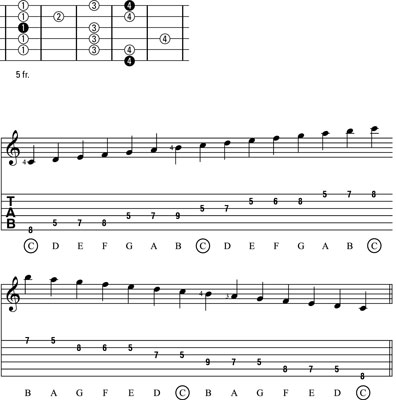You can play a lot of guitar music by simply memorizing five major scale patterns, and the best way to memorize anything is to practice. The following practice exercises will help you to learn major scale pattern #2 on guitar.
Once you learn the major scale patterns, you can play them in many different ways — applying the best pattern for the situation or by changing keys while maintaining a pattern. With 12 major scales and 5 fingering options for each scale, you’re looking at 60 major scales in position. All these options are what make the guitar so incredibly cool.
Major scale pattern #2 starts with the 4th finger on the 6th string and includes one out-of-position note on the 4th string that doesn’t fall within the four-fret span defined by the position and that requires you to stretch up (higher on the neck, toward the bridge) with your 4th finger to reach this note, because it occurs one fret above where the finger naturally falls.
Wherever these patterns contain out-of-position notes, pay special attention; these spots are where you might play a wrong note, or just have trouble playing the right one correctly. If you can’t perform the out-of-position note correctly, try isolating the passage with the problem note and playing it a few times by itself. Then play the whole pattern from start to finish.
The following figure shows major scale pattern #2 in the key of C major in both a neck diagram and in music and tab format. This time, in addition to the fingering notation by the first note (a 4 to the left of the notehead), there is also a fingering indication where an out-of-position note occurs (a 4 next to the 4th-string note B at the 9th fret).

Click here to download and print this scale pattern.
Practice this pattern as many times as you need to in order to make all the notes sound smooth and effortless. When you use the correct fingerings automatically, you know you’re on the right track. After you can successfully finger this pattern in all keys, practice it in rhythm.
Here’s major scale pattern #2 in the key of Bb major in 3rd position in ascending and descending eighth-note triplets. Don’t be afraid of the flats that you see in the key signature of this exercise. Although guitar music is usually written in “guitar friendly” keys that contain sharps in the key signature, this pattern uses more variety because you’re learning patterns that can be moved around and played in any key with equal ease. After all, a flat key is no more difficult than a sharp key or a key with no flats or sharps at all!
As you practice, play each major scale from low to high, slowly, loudly, and deliberately at first to help develop the muscles in your hand and fingers — similar to the way athletes might lift weights. Then play it faster and lighter to more closely approach how the music is actually played in performance. Just be sure to maintain your starting tempo and dynamic level (loudness) throughout the scale.


